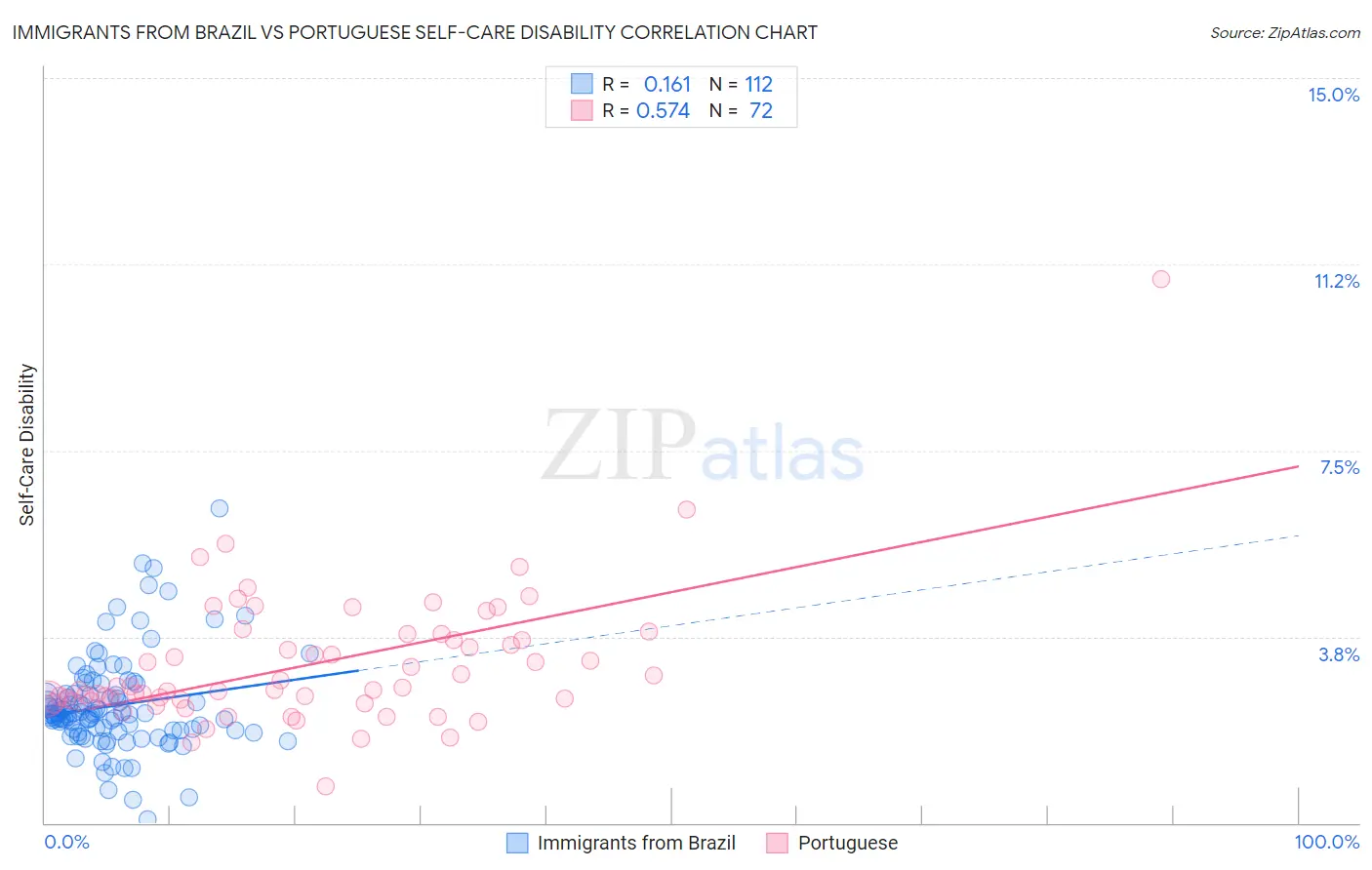Immigrants from Brazil vs Portuguese Self-Care Disability
COMPARE
Immigrants from Brazil
Portuguese
Self-Care Disability
Self-Care Disability Comparison
Immigrants from Brazil
Portuguese
2.3%
SELF-CARE DISABILITY
99.7/ 100
METRIC RATING
50th/ 347
METRIC RANK
2.6%
SELF-CARE DISABILITY
0.4/ 100
METRIC RATING
250th/ 347
METRIC RANK
Immigrants from Brazil vs Portuguese Self-Care Disability Correlation Chart
The statistical analysis conducted on geographies consisting of 342,700,860 people shows a poor positive correlation between the proportion of Immigrants from Brazil and percentage of population with self-care disability in the United States with a correlation coefficient (R) of 0.161 and weighted average of 2.3%. Similarly, the statistical analysis conducted on geographies consisting of 449,515,942 people shows a substantial positive correlation between the proportion of Portuguese and percentage of population with self-care disability in the United States with a correlation coefficient (R) of 0.574 and weighted average of 2.6%, a difference of 14.3%.

Self-Care Disability Correlation Summary
| Measurement | Immigrants from Brazil | Portuguese |
| Minimum | 0.076% | 0.74% |
| Maximum | 6.3% | 11.0% |
| Range | 6.3% | 10.2% |
| Mean | 2.4% | 3.2% |
| Median | 2.2% | 2.7% |
| Interquartile 25% (IQ1) | 1.9% | 2.5% |
| Interquartile 75% (IQ3) | 2.6% | 3.7% |
| Interquartile Range (IQR) | 0.73% | 1.3% |
| Standard Deviation (Sample) | 0.97% | 1.4% |
| Standard Deviation (Population) | 0.97% | 1.4% |
Similar Demographics by Self-Care Disability
Demographics Similar to Immigrants from Brazil by Self-Care Disability
In terms of self-care disability, the demographic groups most similar to Immigrants from Brazil are Latvian (2.3%, a difference of 0.020%), Kenyan (2.3%, a difference of 0.15%), Immigrants from Serbia (2.3%, a difference of 0.17%), Immigrants from Malaysia (2.3%, a difference of 0.20%), and Australian (2.3%, a difference of 0.20%).
| Demographics | Rating | Rank | Self-Care Disability |
| Immigrants | Pakistan | 99.8 /100 | #43 | Exceptional 2.3% |
| Immigrants | South Africa | 99.8 /100 | #44 | Exceptional 2.3% |
| Norwegians | 99.8 /100 | #45 | Exceptional 2.3% |
| Czechs | 99.8 /100 | #46 | Exceptional 2.3% |
| Jordanians | 99.7 /100 | #47 | Exceptional 2.3% |
| Immigrants | Malaysia | 99.7 /100 | #48 | Exceptional 2.3% |
| Latvians | 99.7 /100 | #49 | Exceptional 2.3% |
| Immigrants | Brazil | 99.7 /100 | #50 | Exceptional 2.3% |
| Kenyans | 99.7 /100 | #51 | Exceptional 2.3% |
| Immigrants | Serbia | 99.6 /100 | #52 | Exceptional 2.3% |
| Australians | 99.6 /100 | #53 | Exceptional 2.3% |
| Argentineans | 99.6 /100 | #54 | Exceptional 2.3% |
| Immigrants | France | 99.6 /100 | #55 | Exceptional 2.3% |
| Immigrants | Eastern Asia | 99.6 /100 | #56 | Exceptional 2.3% |
| Immigrants | Belgium | 99.6 /100 | #57 | Exceptional 2.3% |
Demographics Similar to Portuguese by Self-Care Disability
In terms of self-care disability, the demographic groups most similar to Portuguese are Mexican American Indian (2.6%, a difference of 0.080%), Immigrants from Liberia (2.6%, a difference of 0.080%), Immigrants from Bangladesh (2.6%, a difference of 0.15%), Immigrants from Haiti (2.6%, a difference of 0.23%), and Haitian (2.6%, a difference of 0.25%).
| Demographics | Rating | Rank | Self-Care Disability |
| Hawaiians | 0.8 /100 | #243 | Tragic 2.6% |
| Yuman | 0.8 /100 | #244 | Tragic 2.6% |
| Immigrants | Western Asia | 0.6 /100 | #245 | Tragic 2.6% |
| Cheyenne | 0.6 /100 | #246 | Tragic 2.6% |
| Immigrants | Albania | 0.6 /100 | #247 | Tragic 2.6% |
| Nicaraguans | 0.6 /100 | #248 | Tragic 2.6% |
| Mexican American Indians | 0.5 /100 | #249 | Tragic 2.6% |
| Portuguese | 0.4 /100 | #250 | Tragic 2.6% |
| Immigrants | Liberia | 0.4 /100 | #251 | Tragic 2.6% |
| Immigrants | Bangladesh | 0.4 /100 | #252 | Tragic 2.6% |
| Immigrants | Haiti | 0.3 /100 | #253 | Tragic 2.6% |
| Haitians | 0.3 /100 | #254 | Tragic 2.6% |
| Tsimshian | 0.3 /100 | #255 | Tragic 2.6% |
| Immigrants | Central America | 0.3 /100 | #256 | Tragic 2.6% |
| Potawatomi | 0.3 /100 | #257 | Tragic 2.6% |